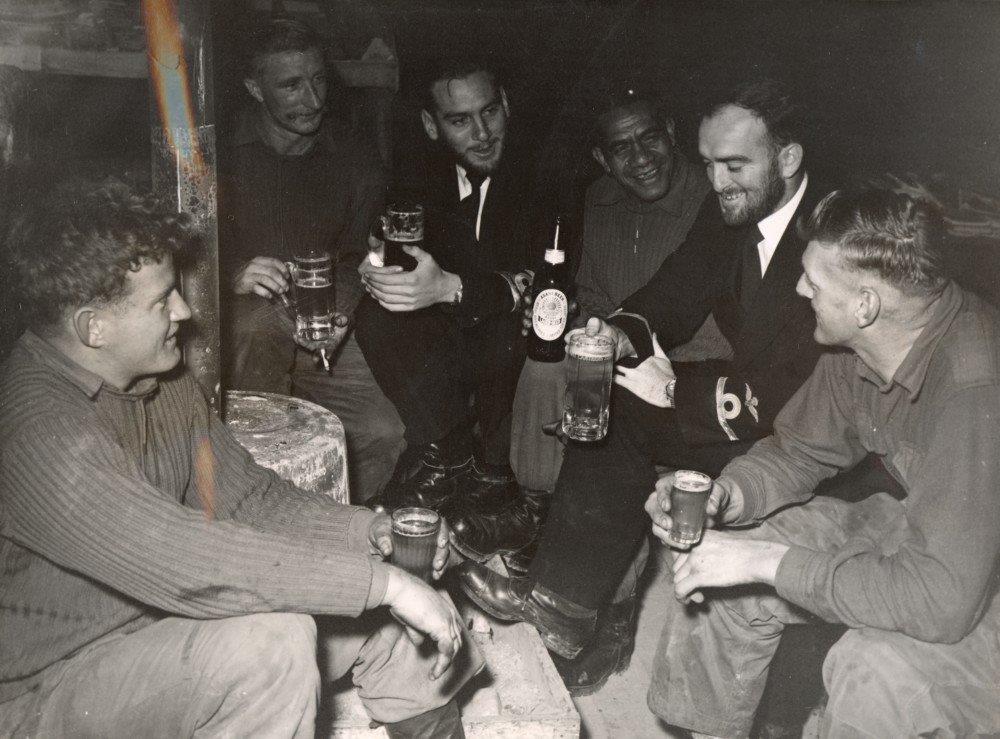
LEUT Leeson (left) and Seamus (Jim) O’Farrell (right) take a little time out to talk to some Diggers during their Korean deployment. With them was Privates Alf Jones, Laurie Woods, Dick Hill, and Athol Wilson.
Sadly, I have to inform you that an Old and Bold, and much respected, Fleet Air Arm officer, Jim (Seamus) O’Farrell, passed away on the morning of 18 August 2017 at the Sacred Heart Palliative Care Hospice in Darlinghurst, Sydney. Jim had been ill for some years, but had a recent downturn after a fall, and was transferred to the Hospice from the Nursing Home where he had been since the loss of his wife, Margaret, earlier in the year.
A Mass of Christian Burial was offered at Our Lady of the Sacred Heart, Avoca Street, Randwick on Thursday 24th August 2017.
The following text is something that Jim put together himself. It was forwarded by one of Jim’s sons, Paul, who has given his permission to use it.
“I joined the Royal Australian Navy as a Recruit in January 1947. Recruit training was carried out at Flinders Naval Depot, Westernport, Victoria, which is also known as HMAS Cerberus.
The RAN Fleet Air Arm was formed at about this time and I was selected for training as a Pilot. This training was carried out by the Royal Australian Air Force at No1 Flying Training School, located at Point Cook Victoria. I was awarded my Wings by the RAAF on 13 December 1951.
This only qualified me to fly land based aircraft and the RAN then sent me to England to do further operational flying training to qualify me as a Carrier based pilot. I spent 6 months at a Royal Navy base at Lossiemouth in the far north of Scotland. There I converted to a Navy version of the Spitfire. I was then sent to Culdrose in Cornwall for about 6 months where I converted to the Sea Fury, the fastest piston engine fighter plane ever to enter service.
I carried out 24 successful deck landings on board HMS Triumph and I was now fully qualified as a Fleet Air Arm pilot.
Back in Australia in January 1953 I joined 805 Squadron, flying Sea Furies from HMAS Sydney, our first Aircraft Carrier, which operated in the Korean area until mid 1954.
Back at the Naval Air Station at Nowra NSW, also known as HMAS Albatross, I converted to the Sycamore helicopter, which I flew on rescue missions during the floods at Maitland about 1955. I served at Nowra as Lieutenant for many years including periods when I trained as a flying instructor with the RAAF at East Sale. I also served as a flying instructor at RAAF Base Point Cook and at RAAF Base Pearce WA.
I was promoted to Lieutenant Commander in February 1961 and became the Commanding Officer of 723 Squadron at Nowra. This was a training squadron where pilots were converted to helicopters. In September 1964 I was promoted to Commander and became Commander (Air) of the Naval Air Station Nowra. This meant that I controlled all aircraft operations from NAS Nowra.
In August 1965 I was posted to HMAS Melbourne, our only carrier, as Commander (Air) where again I was in charge of all aircraft operations and adviser to the Captain and the Flag Officer Commanding the Australian Fleet on the operational use of all air assets. Late in 1967 I was posted to Navy Office in Canberra ACT as Deputy Director of Naval Aviation There it was my responsibility to develop policies within the Fleet Air Arm to meet government directives as required by the Minister for Navy. During this period I made several overseas trips to review aircraft and equipment being considered for purchase by the Australian government.
I was promoted Captain in July 1971 and continued working in Navy Office as Director of Naval Aviation Policy. This resulted in much increased overseas, travel reviewing other navies and their aircraft. On the 26 January 1978 I was made a Member of the Military Division of the Order of Australia, for exceptional performance of duty.
On 16 September 1978 I was promoted to the rank of Commodore. This was followed by a posting to Washington DC as the Australian Naval Attache to the United States Navy. My wife Margaret and three of our sons accompanied me to a residence supplied by the Australian Government, where we lived for three years. It was a large house, fully furnished and with a dining room table to seat 16. For three years we were required to entertain with formal dinners and informal cocktail parties. This was a huge task which I could never have managed without my wife Margaret. When we weren’t entertaining at home we were out attending dinners and receptions at other foreign embassies or dining with Admirals of the USN.
Back in Australia in January 1982 I was posted to Canberra as the Director General Operational Requirements in the RAN. This meant that I headed a staff of about 150 people who were required to obtain and enter into service, ships, submarines, aircraft and their equipments. This was to be a very busy time.
I was pleasantly surprised to receive a letter on 26 March 1982 stating “Her Majesty the Queen has been graciously pleased to approve your appointment as Naval Aide-de-Camp to Her Majesty to date 30 March 1982”. This was a very pleasant appointment, for Margaret and I were able to attend several functions and meet the Queen and her husband when she visited Australia. We were also frequent attendees at official receptions and functions at Government House, Yarralumla, Canberra.
My service of 37 years in the RAN ended on 31 January 1984, just four days before I turned 55.”


